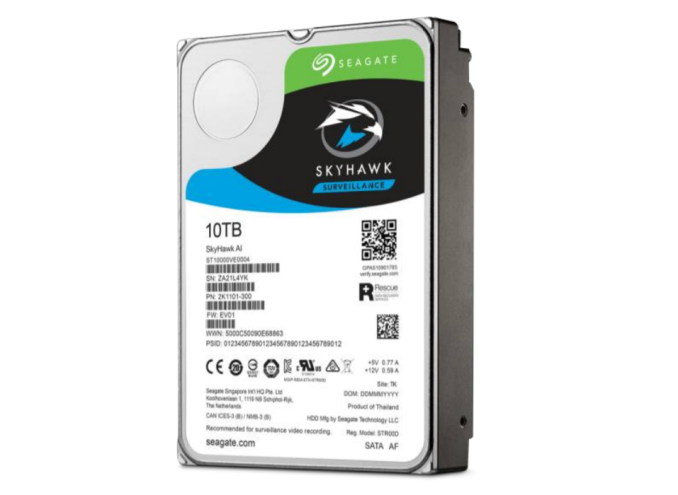Seagate Launches SkyHawk AI HDDs for Intelligent NVRs
by Anton Shilov on November 1, 2017 2:00 PM EST
Seagate has released a new family of hard drives for intelligent network video recorders (NVRs) with 'AI capabilities'. The new Skyhawk AI HDDs are built to simultaneously record footage from dozens of HD cameras and provide data for multiple streams used for deep learning, machine learning, and video analytics applications.
The Seagate Skyhawk AI family consists of 8 GB and 10 TB models featuring a 7200 RPM spindle speed, 256 MB cache buffers and a SATA 6 Gbps interface. The new hard drives rely on Seagate’s seven-disk enterprise-class helium-filled platforms featuring top and bottom attached motors, RVFF sensors, and other enhancements to handle heavy workloads (up to 550 TB per year) in vibrating machines featuring 16 or more drives. Typical Seagate Skyhawk drives used for surveillance systems are rated for 180 TB per year and are not designed for NVRs featuring more than 16 drives (formally, they are rated for systems with 8+ bays).
The heart of the SkyHawk AI drives is their ImagePerfect AI firmware that builds upon the original ImagePerfect technology from Seagate but has several important enhancements. All higher-end SkyHawk drives support ATA streaming technology and can record data from up to 64 HD cameras. It also allows the HDDs can quickly wake up from idle and resume work. What the ImagePerfect AI adds on top of that is a special caching algorithm that enables “low latency and excellent random read performance to quickly locate and deliver video images and footage analysis.” As a result, each SkyHawk AI HDD can record footage from 64 cameras while providing enough read performance for 16 AI streams (8 AI channels).
When it comes to raw performance numbers, Seagate declares 214 MB/s maximum sustained transfer rate, 4.16 ms average latency and up to 7.2 W power consumption for the SkyHawk AI drives. By contrast, the original SkyHawk 8 TB and 10 TB featured up to 210 MB/s maximum sustained transfer rate and 4-4.16 ms average latency (keep in mind that the Skyhawk 8 TB was not helium-filled). Therefore, from a performance point of view, the new AI drives are not tangibly faster than the regular ones and all the improvements are there due to the firmware.
| Seagate SkyHawk AI HDDs | |||||
| ST10000VE0004 | ST8000VE0004 | ||||
| Capacity | 10 TB | 8 TB | |||
| HD Cameras Supported | Up to 64 | ||||
| AI Streams (AI Channels) | 16 (8) | ||||
| RPM | 7200 RPM | ||||
| Interface | SATA 6 Gbps | ||||
| DRAM Cache | 256 MB | ||||
| Peak Sustained Transfer Rate | 214 MB/s | ||||
| Average Latency | 4.16 ms | ||||
| Rated Workload | Equivalent of 550 TB of Writes per Year | ||||
| Power Rating | Idle | 4.9 W | |||
| Operating | 7.2 W | ||||
| MTBF | 2.0 million hours | ||||
| Warranty | 5 Years | ||||
Since the SkyHawk AI drives are based on enterprise-grade platforms, they are also covered by a five-year warranty. In addition, the drives are bundled with Seagate’s two-year Seagate Rescue Services. The SkyHawk AI 10 TB will be available in the U.S. for $449.99, whereas the 8 TB model will cost $349.99.
Related Reading
Source: Seagate











8 Comments
View All Comments
JoeyJoJo123 - Wednesday, November 1, 2017 - link
"The Seagate Skyhawk AI family consists of 8 GB and 10 TB models"I imagine 8 TB* was meant, as later in the article... "By contrast, the original SkyHawk 8 TB and 10 TB featured up to 210 MB/s maximum sustained transfer".
Seems kind of odd to advertise a hard drive of having AI capabilities, but in reality the differences to their other 10TB and 8TB drive offerings is a retooled caching priority and vibration tolerances for 8 ~ 16 bay enclosures.
peevee - Wednesday, November 1, 2017 - link
Everything AI now, even when 0 intelligence is present. Marketoids must be summarily shot.ddriver - Wednesday, November 1, 2017 - link
Ai ai ai....Riding the fad to the max.
Put some RGB LEDs on it FFS. Because comic hero product names are not lame enough already.
Visual - Thursday, November 2, 2017 - link
"simultaneously record footage from dozens of HD cameras""Peak Sustained Transfer Rate 214 MB/s"
Hahahahaha nice joke.
MrSpadge - Thursday, November 2, 2017 - link
With HD they surely mean the low resolution of 1360x768, which was considered "high" in the TV world a few years ago.willis936 - Thursday, November 2, 2017 - link
Surely your NVRs are configured for 1 Mbps h.264 streams.Ninhalem - Thursday, November 2, 2017 - link
Just slap these in a RAID 0 configuration inside Linux. I have 2x 4TB WD Purple drives in RAID 0 for my NVR that work marvelously. Camera recording is a mainly sequential write process. Also, most HD camera recordings are 1080p now.ddriver - Thursday, November 2, 2017 - link
They didn't specify frame rate, I suspect they will manage one frame per second ;)Once again, we see a faddy gimmick supposedly addressing something that is already easily solvable. A good surveillance system will encode and buffer optimum sized chunks of data before writing them to disk.
You can have decent quality 1080p h264 video as low as 8 mbits/s which is 1 mb. So technically, a 200+ MB hdd could service 200 of those streams.
However, an actually HDD will not be able to handle anywhere nearly that if data is continuously streamed in finely grained chunks, because seeking overhead will overwhelm the drive.
But if you apply proper buffering seeking can be reduced to a non-issue. Throwing a gig of ram at buffering will easily allow to achieve the theoretical maximum. No "special AI fad firmware" needed, just a barely-adequate bit of software running on the client machine.